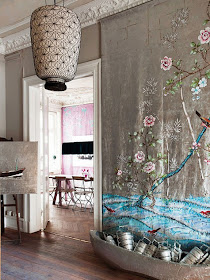Il termine Cineserie deriva dal francese "Chinoiserie" e si riferisce ad un periodo dell'arte europea, a partire dal XVII secolo, in cui si ebbe una notevole influenza dell'arte cinese[1], anche sulla scia di un crescente interesse che l'Europa aveva sviluppato per tutto ciò che fosse esotico, in generale.
Nella decorazione d'interni molti monarchi europei, come Luigi XV di Francia, diedero grande rilievo alle cineserie, miscelandole con lo stile rococo. Intere stanze, come quelle al Castello di Chantilly, vennero dipinte con cineserie ed artisti come Antoine Watteau ed altri portarono grande maestria nello stile.[2]
Padiglioni di svago nel "gusto cinese" divennero comuni nel tardo
barocco e nel rococò tedesco e russo, oltre che in pannelli di
piastrelle ad Aranjuez vicino Madrid. Interi villaggi cinesi vennero costruiti a Drottningholm in Svezia ed a Carskoe Selo in Russia. I tavoli da tè e le vetrine in mogano di Thomas Chippendale, erano abbelliti con trafori, vetri ed inferriate, intorno al 1753-1770, ma omaggi ai primi sobri arredamenti della Dinastia Qing
erano anche abbastanza comuni. Non tutti gli oggetti realizzati secondo
i principi di progettazione cinese rientrarono però fra le "cineserie".
Chinoiseries this term derives from the French "Chinoiserie" and refers to a period of European art,seventeenth century, which had a remarkable influence of the Chinese [1], even in the wake of a growing interest in the 'Europe had developed for everything that was exotic in general.
In interior decorating many European monarchs, such as Louis XV of France, gave great prominence to chinoiserie, mixing them with the rococo style. Entire rooms, such as the Château de Chantilly, were painted with chinoiserie and artists such as Antoine Watteau and others brought great skill in style. [2] Pavilions leisure in the "Chinese taste" became common in the late Baroque and Rococo German and Russian, as well as in tile panels at Aranjuez near Madrid. Entire Chinese villages were built in Drottningholm in Sweden and Tsarskoe Selo in Russia. The tea tables and cabinets in mahogany Chippendale Thomas, were decorated with tracery windows and railings, around 1753-1770, but sober homages to early Qing Dynasty furniture were also quite common. Not all items made in accordance with the design principles, however, between the Chinese returned "chinoiserie."













Nessun commento:
Posta un commento